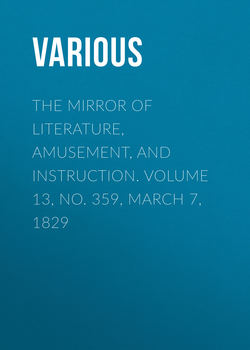Читать книгу The Mirror of Literature, Amusement, and Instruction. Volume 13, No. 359, March 7, 1829 - Various - Страница 1
RUGBY SCHOOL
ОглавлениеRUGBY SCHOOL
On the eastern border of Warwickshire, about 13 miles from Coventry, and 16 from Warwick, stands the cheerful town of Rugby, a place of great antiquity, but of little note previous to the erection of a grammar-school there, towards the close of the sixteenth century. The circumstances under which this school was founded, and the rank it has attained among our classical seminaries, may probably be interesting to the reader.
Rugby School was founded in the ninth year of Elizabeth, by Lawrence Sheriff, grocer, of London, chiefly as a free grammar-school for the children of the parishes of Rugby and Brownsover, and places adjacent. For the accommodation of the master, who was, "if it conveniently might be, to be ever a Master of Arts," he bequeathed a messuage at Rugby, in which it is probable he had himself resided during the last few years of his life, and he directed that there should be built, near this residence, a fair and convenient school-house, to defray which expense, and of a contiguous almshouse, he bequeathed the revenue of the rectory of Brownsover, and a third portion of twenty-four acres of land, situate in Lamb's Conduit Fields, "near London," and termed the Conduit Close. These eight acres were of trivial value at the period; and in 1653, the trustees of the property paid the schoolmaster a salary of 12l. a year, and each of the alms-men 7s. 7d. In 1686, the Lamb's Conduit property was leased for fifty years at 50l. per annum. The metropolis increased, and stretching one of its Briareusian arms in this direction, the once neglected field rose in value, and in 1702 (thirty-four years before the expiration of the above term) the trustees granted a fresh lease to William (afterwards Sir William) Milman, of forty-three years, to commence at the termination of the former lease. Building was not then a mania, and Sir William obtained his term for 60l. per annum; so that until the year 1780, the annual produce of the estate belonging to the Rugby charity, was only 116l. 17s. 6d.! But, shortly after the grant of an extended term to Sir W. Milman, handsome streets of family houses sprung up, and it was computed that a ground-rent of at least 1,600l. would accrue to the charity on the expiration of his lease. A much greater income has, in fact, arisen, and the revenues will be materially increased on the termination of the present leases.
The flourishing finances of this noble institution are well managed by twelve trustees, chosen from the nobility and gentry of the country.1
The ancient buildings of the Rugby seminary were a humble tenement for the schoolmaster, a principal school-room, and two or three additional school-rooms, built at different times, as the finances would allow. These being found too limited, in 1808 the trustees commenced the erection of the present structure, from the designs of Mr. Henry Hakewill. It stands nearly on the same spot as the former humble building, and is composed of white brick, the angles, cornices, and dressings to the windows and openings being of Aldborough stone. The style of architecture is that of the reign of Elizabeth, the period at which the school was founded. The building is massy, august, and interesting from its graceful disposition of parts. The principal front is that represented in our engraving, which extends 220 feet.
The schools are entered by a gateway opposite the street, which leads to the principal court, a fine area, 90 feet long by 75 feet wide, with a plain cloister on the east, south, and west sides. The buildings on the south of the court comprise the dining hall, belonging to the boys in the head master's house, and three schools for different classes; those on the west are occupied by the great school; and on the north are the French and writing schools. The east side adjoins the offices belonging to the head master's house. About sixty boys are accommodated here; the remainder lodge in the houses of the other masters, and in the town of Rugby.
Lawrence Sheriff, the benevolent founder of this institution, was born at Brownsover, whence he removed to London, where he kept a grocer's shop in Newgate-street. A more gratifying portrait of true beneficence than Sheriff's bequest can scarcely be found in British annals; and this gratification is greatly enhanced by the justice with which his intentions have been carried into effect at Rugby. The alms-houses were originally for four poor old men; but the dwellings have been augmented in proportion to the increased revenues.
1
Their annual meeting is in August, when the examination takes place. Fourteen exhibitions have been instituted, each of the exhibitioners being allowed forty pounds per annum to assist in their support, for seven years, at either university.
